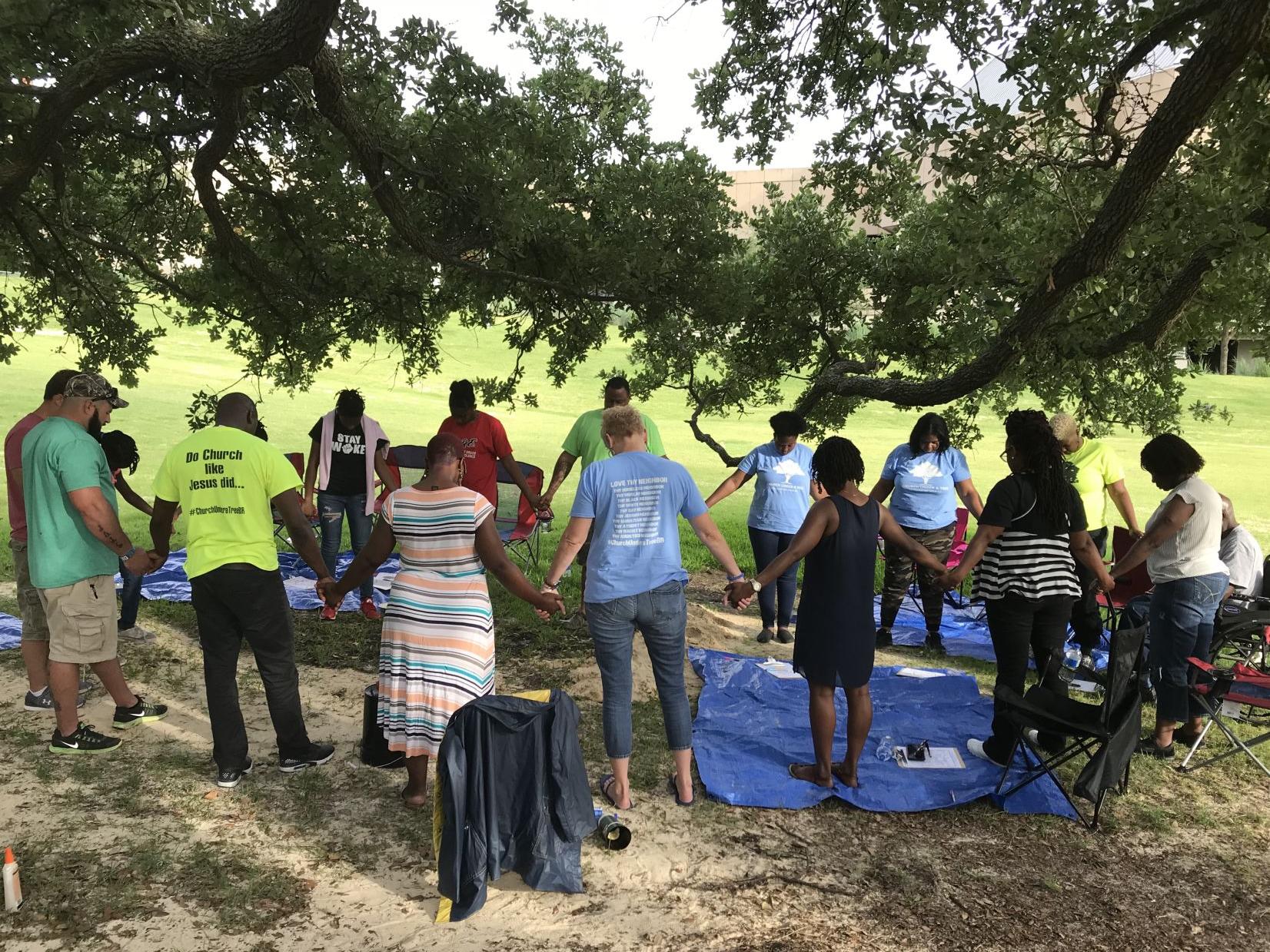By Felix Sumba
When speaking about the instrument of advancing His Kingdom, Jesus says He is building his Ekklessia and the gates of Hades will not prevail against it. (Matt 16:18). Christ announced the instrument for the task of advancing God’s kingdom as His Ekklessia.
Jesus had the option of purifying the temple system and using it. He did not. Instead he passed judgement on its corruption at its cleansing (Matt. 21:12–17, Mark 11:15–19, and Luke 19:45–48) John 2:13–16) its abuse of widows Mark 12:38-44, and figuratively as the fig tree full of life but with no fruits (Mark 11:12-25). In 60 years, the temple system would be no more. Intead, Jesus opted for an Ekklesia.
Jesus is quoted as having used the term Ekklessia on two occasions only. In both instances he did not bother to define it. Why? Because this was a term widely understood by the people of His time.
Ekklessia is a term derived from the Greek/Roman governance. It is not a religious term but a civil and secular one. It refers to an assembly of citizens gathered to discharge governance matters over a jurisdiction in which they reside.
An Ekklessia is defined by “who” (citizens) and “what” (what they do/transact). In an Ekklessia, citizens assembled to discharge whatever matter was laid before them.
In Greek culture, one needed to be above 18 years and to have participated in a war or the defence of the city on at least two occasions to qualify as a citizen. This was essentially someone who had shed blood and had skin in the game that would then be viewed as a citizen and be empowered to participate in decision making on behalf of the City state.
While Ekklessia has a Greek origin, the Romans had adopted it and enhanced its meaning and application.
In Roman thinking, anywhere a Roman citizen was, he represented the full might of the Roman empire and when two or more Roman citizens met, they could discharge matters on behalf of Rome. This became even more practical as the empire grew and its citizens had to settle in lands further away from Rome.
As Rome grew and expanded, it created many new citizens and heroes who could not be accommodated in Rome. This created the need for colonies where Roman citizens lived. To Roman law, any assembly of two Romans constituted the Roman state and it’s presense. That place became “Rome” just as if it was Rome itself. It is to this that Jesus appeals when he says that “where two or three are gathered in my name, there I am in the midst of them” (Matthew 18:20). It is the presence of citizens assembled to discharge Kingdom matters that makes an Ekklessia and confers the presence of Jesus in their midst
To harm a Roman citizen anywhere would result in the full might of Rome visiting that space and woe to the people who had committed the wrong.
Jesus chose a secular civil government institution as the model on which He would recolonise the rebellious earth back under God. This was the instrument for the advancement of the Kingdom.
The word church on the other hand is derived from a Germanic word kirche, meaning something of God or belonging to God.
Notice the huge difference. One term restricts the sphere of God’s influence to a place (the church), the other applies the sphere of the Kingdoms influence to everything. Kirche restricts the divine to a building and what transpires therein while the Ekklessia explodes the sphere of God’s influence beyond the building or the ‘religious’ to all matters wherever the citizens of the kingdom are.
The Ekklessia is not a place
The entry of Jesus marked a great transition from the old to the new, a fulfillment of the foreshadowing in the OT and the unveiling of the promise contained in the OT, with the new.
When asked about where to worship, Jesus neither affirms the temple in Jerusalem, nor any other place or building. When Jesus spoke to the Samaritan woman at the well, several issues were at play. One that came up was about the right place to worship. The Jews saw the temple in Jerusalem as the place of God’s dwelling and the only rightful place to worship. The Samaritans saw the mountains as the place to meet God. But Jesus rejects both options and moves the issue from a place, to the people – those who will worship God in Spirit and in truth. John 4:4-26
He says to the Samaritan woman:
“Yet a time is coming, and has now come, when the true worshipers will worship the Father in the Spirit and in truth, for they are the kind of worshipers the Father seeks. God is spirit, and his worshipers must worship in the Spirit and in truth.”
John 4:23-34
Kirche restricts the divine to a building and what transpires therein while the Ekklessia explodes the sphere of God’s influence beyond the building or the ‘religious’ to all matters wherever the citizens of the kingdom are.
Felix Sumba
He captures in this passage the prophetic nature of his presence when he says a time is coming, then concludes that it has now come, with him. That in this New Dispensation, true worshippers will not be defined by where they worship but who they are and how they worship — by the Spirit.
But it doesn’t end there. In Jesus final week leading to his death and resurrection, he visits the temple. What he sees there so grieves him that he not only upturns the tables and whips the money lenders, he actually passes judgement on the temple, bringing to an end the temple age and its corruption. (Mark 12)
In Mark 11, we encounter a strange story where an “innocent” fig tree is cursed. Why would Jesus curse the innocent fig tree?
Mark employs a storytelling technique where two or three stories are interwoven together so they interpret each other.
It begins with Jesus entering Jerusalem and making a bee line for the temple. This time, he does nothing but observe. He observes a temple full of activity. He then heads to Bethany, just outside Jerusalem where he spends the night.
The next day, while hungry and on another trip to Jerusalem from Bethany, he observes a fig tree, full of leaves. But on inspecting it, he finds no fruit. He then proceeds to curse this tree, and by the next day, it is withered and dead.
What is Mark saying to us here? That, like the tree, the temple was full of activity, but no food or life. It used the resources provided to nourish itself and did not provide food/fruit/nourishment for those who by divine appointment, were to obtain nourishment from it.
The widow in Mark 12:41-44 who by right was to get her sustenance from the temple according to the Law of Moses was being exploited by this same system. Her story, while a commendation for sacrificial giving, is at the same time a strong condemnation of the temple system and the religious leaders (Mark 12:37-41).
The entire chapter 12 of Mark is a detailed prosecution by Jesus/Mark of the temple set up and its leaders. Within 60 years of this, the temple was no more.
As Christians the message should be clear. The temple was supposed to be a place of ministry. A place where people would encounter Yahweh both directly and through the ministry of those in charge. However, the temple, like the fig tree, became about itself and not about God nor the people. The temple set up was to be salt to the world, but if the salt looses its saltiness what is left but to throw it out to be trampled in the darkness. (Matt. 5:13)
New Testament temple and priests
Jesus introduces a new temple concept when before his accusers he says: “Destroy this temple and in three days I will raise it up”. (Matt. 26:60) To Jesus, the temple stops being a building made of stones but of humans.
The writer of Peter put it thus:
“As you come to Him, the living stone, rejected by men but chosen and precious in God’s sight, you also, like living stones, are being built into a spiritual house to be a holy priesthood, offering spiritual sacrifices acceptable to God through Jesus Christ”
1 Peter 2:4-5
If there is still a doubt as to what the temple is in the New Testament, the day of Pentecost (Acts 2) offers a beautiful mirror image of the dedication of the temple by Solomon (2 Chronicles 7).
Upon completion of the temple, Solomon offered sacrifices and invited God to dwell in his house. The presesnce of God came down as a fire that consumend the sacrifice and filled the temple such that the priests could not go in.
At Pentecost, the Holy Spirit comes down as fire, similar to the temple dedication, and rests on top of the believers consuming the living sacrifices and dwelling in his new temple(s).
Paul puts it this way in 1 Corrinthians 6:19-20:
“Do you not know that your body is a temple of the Holy Spirit who is in you, whom you have received from God? You are not your own; you were bought at a price. Therefore, glorify God with your body.”
Many reduce this verse to its context of sexual purity. However, the greater truth of who we are and what we are is what Paul is using to make the point about sexual purity. It is that we are the temple of God and, therefore, our lives should reflect this reality, not just around sexuality, but in every sense.
At His death, the curtain that hid the Holy of Holies is torn apart, making this most holy place accessible to all who believe (Heb. 4:16). To guarantee this access, Jesus makes those who believe part of a rare species, royal priests (1 Peter 2:9). Only two ever existed in Biblical history – Melchizedeck and Jesus.
While priests focused on what were termed as “religious affairs” or “temple matters”, New Testament believers have a jurisdiction expansion to matters beyond the temple or religion. They occupy governance too given they are royalty.
The story of scripture is the story of Eden regained. Man began as a royal priest in Eden (Adam & Eve) and lost this through the Fall. Along with this was lost the presence and fellowship of God as exile became man’s reality. God, through Abraham, sets about restoring this fellowship and communion.
At first, God’s presence is sporadic as the Spirit fills certain persons from time to time.
Then, the presence of God dwells amidst his people in the tabernacle (mishkan in Hebrew — Does it remind you of a Swahili word for home?) in the desert that was at the centre of the encamped tribes of Israel.
This presence then moves to Solomon’s temple, turning Jerusalem into Zion, the dwelling place of God.
But Jesus, the Emmanuel, comes and moves this presence from the temple of stone to that of flesh. God now is not confined to a place but liberated into the hearts and bodies of true worshipers.
The age of stone temples and altars is now gone. We are the living stones and altars. We are the temple in which the Spirit dwells. The days of the priestly class is gone and now a new age of the Royal Priest is here.
By the age of the apostles, the era of Yahweh dwelling in a building made of stone was over. Believers knew they were the temple of God in the New Covenant. They knew that the Holy of Holies was within them, confirmed by the Spirit of God. They knew they were the new citizens in the Ekklessia of the Kingdom of God, with a mandate to spread the Good News that the Kingdom of God is here.
So, why are we so intent on reducing believers to something beneath this with clericalism?
A shift
In the same way that God’s presence was decoupled from the temple, Jesus decoupled it from the Sabbath to and from any special days by extension. The Jews rested on the Sabbath, and although there was some worship on this day, the Sabbath was not a day of worship. The temple was open throughout and those who sought to worship were free to do so on any day.
Sadly, we have gone back to living as if buidlings made of stone are God’s temple; as if there are altars that we can build holier than God’s own altar in us.
We have lost the essense of the New Testament and are busy trying to rebuild the temple system and the priestly class.
But it is not about buildings and days of worship. It is about the Ekklesia of God whenever and wherever, discharging Kingdom affairs. It is about communion with the triune God and with brethren. It is about, where two or three are gathered in His name.
Clericalism and a focus on the Sunday kirche activities does not encourage this, it deducts from it. It hinders focus on people, fellowship, communion and discipleship.
Why Care?
The focus on building takes attention from people and the making of disciples to the maintenance of the elaborate structures we have now substituted for God’s temple. How much have you as a community of believers spent on buildings as compared to what you’ve spent on people in need both within and outside your community?
Secondly, as we focus on the building, we re-instate the sense that the building is God’s house and not the believers.
Although most Christians will intellectually acknowledge that the building is not God’s house, our lived experience testify that we indeed hold the building as God’s house.
Although most Christians will intellectually acknowledge that the building is not God’s house, our lived experience testify that we indeed hold the building as God’s house.
If we lived with the new inspiring reality that our bodies are the temple of God, our conduct outside the Sunday meeting would radically alter.
Third, when we define narrowly the scope of God’s ministry, we lock out the influence of the Ekklessia from the areas God is calling us to. If the things of God are confined to church, then where is the place of justice, mercy, the stranger, the widow the poor who is outside the four walls?
The reality is that the church as the Kirche is widely conceived and understood by many is a wide departure from the Ekklesia of the early Church history and this has had a significant influence on how we understand our faith.
The purpose of this article is to acknowledge and affirm what many may have sensed in their time in the Kirche — that it is not home.
The Spirit is moving in a great way for an awakening that will break the Kirches and reform them into Ekklesias; or He will draw those who are His out into the Ekklessia outside the formal structures.
For others, as with the faithful of old, the call may be to remain in the Kirche and to model within it what it means to be a member of the Ekklesia both individually and by forming a smaller group that will offer the life and fellowship the Ekklesia is meant to embody.
The Ekklesia was never meant to re-establish the temple age in other nations. It was meant to bring an end to the age of temples and altars made of stone. The Ekklesia wasn’t meant to re-establish a new mediating priestly clergy. It was meant to establish a priesthood of all believers.
The Ekklessia is focused on disciplining and maturing believers and ministering to one another and to others in need. The Ekklesia is meant to be a conduit of the Kingdom of Heaven in whatever place two or three are gathered in Christ’s name.
To the extent to which it becomes a Kirche of religious activity and impersonal, mediated fellowship, it takes us back to the temple age and miscarries the new reality. Emmanuel is God with us, not God of the priests or the temple but of THIS temple of flesh and bones.
Felix Sumba is a Biblical scholar, lover of Theology & Anthropology, accountant and keen observer of local & international politics.




Wow! Quie enlightening and so on point thank you for sharing